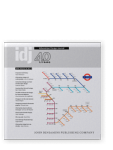Vol. 25:3 (2019) ► pp.315–325
Visual communication design
Caught between two stools
Having graduated in architecture at the University of Technology Wien [Vienna], I subsequently engaged in post-graduate studies at The Bartlett School of Architecture and Planning / University College London. Corporate design and signage design attracted my attention. Back home a major bank and Vienna airport (VIE), among others, were the first clients of my company. As chairman of Committee 133 “Public information symbols” of “Austrian Standards”, I was responsible for the elaboration of several theme specific national and international standards.
In 1993 I founded the IIID International Institute for Information Design. Several r&d projects within the frame of the 6th and 7th European Union Framework Programmes for Research and Technological Development were carried out. However, due to the required but denied support from the Austrian Ministry of Science and Research, the founding of an interdisciplinary institute, affiliated to the United Nations University (UNU), did not materialize. No chance either to establish “Visual Communication Design” at a local university. Until now the Department of Typography and Graphic Communication of The University of Reading (UK) seems to be the only theme specific institution on tertiary university level in Europe. Challenges nowadays range from legible medical package inserts to a much required unified system for the European Union highway signs.
Article outline
- 1.Introduction
- 1.1The Bartlett, Willy de Majo, and ICOGRADA
- 1.2The “Z” – forerunner of Bank Austria, and other clients
- 1.3Public Information Symbols – an essential part of ISOTYPE communication – to safeguard understanding across language barriers
- 2.Graphic communication: Art or science?
- 3.Graphic design for the elaboration of the sustainable rudiments of the design of the future, focused on people
- 4.Interdisciplinary “Visual Communication Design” pending
- 5.Challenges
- 6.Summing up
-
References
